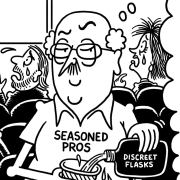Chewbecca posted:Thanks tyd Hopefully you can get some insight on the pains either way. Certainly the, ahem, interesting thing about anxiety is that it can absolutely cause physical symptoms, which are varied and many! Shortness of breath, heart racing, extra sweating, chest tightness and so on and so forth. In my case I get into this loop where I am anxious, I get physical symptoms, these make me more (mentally) anxious, which often makes me physically anxious and so on. Back when I had insurance, I found my anti-anxiety meds helped a lot, because they'd kind of short-circuit the entire process and I could be a lot more chill. I did have a month once where I had weird chest pains and even went to the doctor about it and there was nothing conclusive. This was before covid. It went away on its own lol.
|
|
|
|
|

|
| # ? May 25, 2024 14:59 |
|
Covid variants over the past 6 weeks (in the US) USA XBB has decreased from 2.5% to 0.2% XBB.1.5 has gone from 84.5% to 66.9% XBB.1.5.1 went from 1.9% to 2.4% XBB.1.16 has gone from 2 to 12.5% (525% increase!) XBB 1.9.1 from 3.3 to 9.4% 185% increase XBB 1.9.2 from 1 to 3.7% (270% increase!) *XBB 2.3 from .7 to 2.7% 283% increase BQ.1.1 from 1.8 to 0.3 CH.1.1 from 1.3 to 0.2 FD.2 from 1.1 to 1.6 Ba5, BA.2, BN.1, BQ.1 have gone from less than 1 to not registering at all. *XBB.2.3 was added this week and then separated out from others retroactively.
|
|
|
|
Snowglobe of Doom posted:Here's links: I hopped to the middle of that first thread,which ended up being March 18, 2020, shortly after the world got spooked and everyone entered "lockdown"
|
|
|
|
That stuff will never ever be allowed to happen again in our lifetime.
|
|
|
|
Ghostse.cx posted:I hopped to the middle of that first thread,which ended up being March 18, 2020, shortly after the world got spooked and everyone entered "lockdown" lol there were a few weeks where we scaled a mountain from which we could see better things on the horizon we stopped six feet from the summit, said "gently caress it," and climbed back down
|
|
|
|
Pittsburgh Fentanyl Cloud posted:lol there were a few weeks where we scaled a mountain from which we could see better things on the horizon Without all the sounds from the man made noise machines, it was much easier to hear the gossamer tones of John Sebastian singing Welcome Back.
|
|
|
 I haven't personally seen this prompt yet, but I figured it was only a matter of time. COVID tweets are likely already getting de-boosted, and it seems like this is the next step there-- the final step being autoflags for ToS violation or straight up shadowbans (maybe on a per tweet basis)
|
|
|
|
|
Pittsburgh Fentanyl Cloud posted:lol there were a few weeks where we scaled a mountain from which we could see better things on the horizon more like we climbed six feet and stopped six miles from the summit, because as nice as it was, it wasn't much in the grand scheme of things. and even that was too much to tolerate for those in power and a good chunk of the general population
|
|
|
|
I’m in NYC and there are a lot of people still wearing masks. more than half of them aren’t covering their nose
|
|
|
|
Okuteru posted:https://twitter.com/CoronaHeadsUp/status/1655632224446734343?t=7tnv5p4n379kDP_UV8jgBw&s=19 quote:Combined with its induced pro-inflammatory response, SARS-CoV-2 infection leads to neuronal dysfunction, resulting in ‘brain fog’, as cognition requires a high and uninterrupted supply of oxygen (Figure 1) [3]. If energy metabolism is compromised, the resulting impairment of the immune response serves to increase the spread of the virus within an individual and between individuals. Therefore, the development of ‘brain fog’ as a long-term outcome of SARS-CoV-2 infection may be considered to be an evolutionarily conserved and strategic mechanism on the part of the virus that aids its spread and survival.
|
|
|
|
Wish I could return to the time when I thought medical professionals were experts on healthcare hahah.
|
|
|
|
Joementum posted:I’m in NYC and there are a lot of people still wearing masks. I was watching some show a little while back, probably Forensic Files or something in that vein, and I noticed during the Getty Images B-Roll of a DNA technician, she was dicknosing a surgical mask. I mean yeah, that was probably a staged photoshoot, but it didn't give me any confidence about the future of humanity and DNA comparisons not getting tainted because a technician doesn't know how to properly wear a mask.
|
|
|
|
my favorite is surgicals upside down. like I know the majority of people are just going through the motions but how can you put it in and not realize it’s on upside down unless it’s on purpose because you don’t want the nose piece clamped down.
|
|
|
|
Ghostse.cx posted:I was watching some show a little while back, probably Forensic Files or something in that vein, and I noticed during the Getty Images B-Roll of a DNA technician, she was dicknosing a surgical mask. "DNA evidence suggests DNA technicians are raping murderers"
|
|
|
|
Reading more, I think the authors of that editorial may have brain fog themselves: quote:Recently, patients with COVID-19 and CNS involvement have shown psychological symptoms, behavioral changes, cognitive impairment, confusion, and poor concentration; collectively termed ‘brain fog’ [14]. Sci-hub has most of these papers, hit up my PMs if you want a PDF of the ones that it doesn't have or that aren't free already.
|
|
|
|
Trixie Hardcore posted:Is this a useless dose? I had been thinking of trying again to get monkeyvaxxed. Last year I tried to get it and got turned away because I’m a cis lady but I was hoping they might let me get vaxxed now, but if it’s ineffective then I’m not going to bother. I don't think it's 100% useless but honestly there's not a whole lot of data out there. Supposedly the CDC will release some data later this month but right now I can't even figure if it's anything basic like >50% effective at preventing infection.
|
|
|
|
Zantie posted:Tests absolutely still work assuming they weren't sat in the sun or way expired. Shiroc posted:Is the US still doing the bullshit doses? That's part of why I never wanted to bother with getting the second ones. My first one was a real one. Zantie posted:As far as I can tell yeah, they switched to two 0.1ml intradermal doses and never bothered to change it back to the original 0.5ml subcutaneous dose. DominoKitten posted:I joined a medical study as the adult control arm tbh it seems likely these intradermal vaccine doses are not preventing infection as intended in populations w presumptive post-covid compromised immune systems
|
|
|
|
Hellequin posted:ME/CFS Pt. 1 Apologies in taking so long to getting around to writing part two here, I’ve been pretty wiped the past month and a bit. I don’t think there were more than a handful of days where I spent more than a few hours not horizontal. On top of that, my 2013 MacBook Pro died meaning I couldn’t work from bed and then my glasses broke which meant spending a few days at my parents’ house to get a ride to the optometrist all of which just knocked me out a bit more. It’s been a month. This is definitely going to be a three part post (if not four) as the further along I get the more rot I dig up. I left the narrative at the CDC renaming Myalgic Encephalomyelitis to "Chronic Fatigue Syndrome" in 1988, and the beginnings of a series of diagnosis redefinitions which expanded criteria beyond the point meaninglessness, with the promise to cover the Oxford definition of 1991 and the CDC’s Fukuda definition of 1994 where we would see the introduction of certain key figures in the British Biopsychosocial school of psychiatry. Before covering the Oxford definition of 1991, I want to first jump ahead to 1995 with an internal report published and a symposium held by insurance conglomerate UNUM (later UnumProvident, presently UNUM Group) in order to adduce the motive in operation behind the progressive expansion of diagnostic criteria and medical minimization. Dated April 4th 1995 the internal report "Chronic Fatigue Syndrome Management Program" disclosed that insurance claims for ME had risen an astonishing 460% in the final years of the 1980s and first years of the 1990s and noted that in terms of overall insurance costs, ME/CFS came to rank second on the provider’s list of cost payouts, three places ahead of HIV/AIDS. UNUM stood to lose potentially tens or hundreds of millions of dollars in claim payouts. To avoid having to make these payouts the memo announced that a strategy would be needed, of which this memo would play a part as it downplayed biological evidence, accuses a majority of sufferers to be liars and malingerers, and derogatorily refers to the disorder as "neurosis with a new banner". But perhaps I should simply it speak for itself: "Chronic Fatigue Syndrome Management Program from UNUM” posted:1.3 Evolution If the primary motive for the insurance companies was financial, what was in it for psychiatry? This requires something of a digression, but a necessary one. By the 1970s psychiatry as a field had a credibility problem. The old orthodoxy rooted in psychoanalytic theory offered little in the way of scientifically rooted explanatory power or effective treatment. Increasing outcry over the dehumanizing and brutal character of inpatient psychiatric wards and the use of invasive treatments which left patients incoherent and incontinent such as electro-convulsive therapy, insulin shock therapy, and trans-orbital lobotomies lead to the emergence of a psychiatric survivors movement modelling itself on the civil rights movement which further eroded the prestige and power of psychiatry. This nascent anti-psychiatry movement had not only shed light on the abuses suffered by the mentally ill but levied critiques against the very epistemological foundations of psychiatry in questioning the validity of psychiatric diagnoses themselves, by which the critics were proved right as psychiatric diagnosis was revealed to be of dubious objectivity in the Rosenhan experiment. The field would have to reinvent itself; two competing models would emerge, the first a “return to medicine” biomedical model which would advance the chemical imbalance theory of mental illness and make psychopharmacology the primary approach to psychiatric treatment. The second model would construct a sort of progressive facade on top of the Freudian foundations, this would be the biopsychosocial model. The biopsychosocial model was designed in part as rescue package for psychiatry, shoring up its credibility, as the model promised a boost in patient acquiescence, the possibility of a more “scientific” and progressive approach to mental health and a riposte to the critiques of the anti-psychiatry movement. By changing the phrasing from “hysteria” or “neurasthenia” to “aberrant illness belief” or “conversion disorder” the psychiatrist maintained his diagnostic authority. Of course the promise of quick cash “consulting” on the side were welcome perks, as were the free plane tickets, hotel rooms and meals at insurance industry sponsored events like the 1994 UNUM symposium. The UNUM symposium held in London a month following publication of the aforementioned report featured two star speakers, Michael Sharpe and Simon Wessely, both psychiatrists from the UK whose presence at the symposium was to advise employers on how best to deal with employees on long term leave who were diagnosed with "CFS", it should be noted that the program for the symposium described ME/CFS as "the malingerer's charter". Wessely spoke on the “myth” of ME while Sharpe gave a talk on the use of antidepressants and cognitive behavioural therapy to treat these malingerers. Curiously, both these men who would continue to work closely with UNUM (other organizations Wessely has been associated with include HealthWatch, previously called “The Campaign Against Health Fraud” a pharmaceutical and insurance industry linked campaign dedicated to the opposition of “unnecessary treatment of non-existent disease” and the medical consulting firm PRISMA which works with insurers in providing rehabilitation programmes for “hopeless cases”) as consultant medical "experts" denying claims had a few years earlier been involved in the redrafting of the diagnostic criteria for ME/CFS in 1991 and again in 1994. Their work in redrafting the definitions of the disease would make it infinitely easier for UNUM to deny claims, and would also dilute the patient pool to such a degree as to slow, confuse and halt research into biomarkers by flooding the literature with inconclusive, useless papers. The 1991 Oxford criteria was the result of a meeting convened by three psychiatrists, chaired by another, and of the 21 attendees eight happened to be psychiatrists, among them Michael Sharpe, Simon Wessely, and Peter White (future author of the PACE trial). The genesis of this meeting was, according to chair Anthony Clare, on account of "a group of patients with a cluster of symptoms [...] who get a lot of publicity". (Consensus on research into fatigue syndrome: BMJ 1990: 300:382 (https://ptpimg.me/ubsfl2.png) Astonishingly, the meeting discarded all medical "signs" in constructing its definition, i.e. any test that showed abnormality in cellular metabolism, any MRI displaying altered or diminished brain functioning or structure, any objective measurement of autonomic dysfunction such as lower variability in resting heart rate, and any demonstrable irregularity in circulatory function such as abnormal body temperature were to be ignored in favour of a definition which would rely entirely on "symptoms" i.e. the subjective experience of the patient. And of these symptoms, those which had previously been the signature for the disorder, post-exertional malaise and cognitive dysfunction, were to be removed from the criteria, and in their place would stand a sole symptom, "fatigue", which was never precisely defined and it remained unclear as to what qualified. Moreover, any primary medical diagnosis which might cause fatigue (e.g. cancer, hypothyroidism) would exclude a patient from a diagnosis of Chronic Fatigue Syndrome, however a psychiatric primary diagnoses that resulted in “fatigue” would not. This decision would essentially ensure that the illness would be psychologized. Not long after the publication of the Oxford definition, the CDC would seek to again revise its own definition of Chronic Fatigue Syndrome, and under the lead of Dr. Keiji Fukuda sought substantial input from both Wessely and Sharpe. The 1994 Fukuda definition extended the criteria to include all medically unexplained "fatigue" that had lasted at least six months. Further, the 1994 definition advises against doing screening tests, but states "we consider a mental status examination to be the minimum acceptable level of assessment". Under the Fukuda definition it’s been noted that patients whose primary diagnosis is major depression would easily qualify for a diagnosis of CFS despite not experiencing what had previously been the hallmark symptom of PEM. The ostensible reasoning for including strictly psychiatric illnesses was that “such psychiatric conditions are highly prevalent in persons with chronic fatigue and the chronic fatigue syndrome, and the exclusion of persons with these conditions would substantially hinder efforts to clarify the role that psychiatric disorders have in fatiguing illnesses”. For much of the ‘90s and early ‘00s the Oxford and Fukuda definitions would remain the most commonly used definitions in research and most frequently used in clinical care. So greatly was the diagnostic criteria expanded under the Oxford and Fukuda definitions that the prevalence rate of ME/CFS would rise to an approximate 2.2 and 2.6 percent of the population respectively (however if one were to exclude psychiatric illnesses, these rates would fall to .7 and .5 percent, one need only imagine the effects this would have on the research literature). In a letter sent to Dr. Fukuda shortly after publication of the Fukuda definition and obtained via FOIA request, the NIH’s Stephen Straus congratulated Fukuda on forging a definition that was “politically acceptable” and went on to state: quote:My own sense is that a few years of use [with the Fukuda definition] in the field will once again verify that there is no demonstrable or reproducible differences between individuals who meet the full CFS criteria and those who can be said to suffer Idiopathic Chronic Fatigue. This would beg the question of whether additional revisions to the definition are warranted, or its entire abandonment. It must be noted that during the midst of this definition shift of ME/CFS from a neurological/neuroimmune disorder to a psychiatric disorder, the World Health Organization which had listed ME as a neurological disorder in 1969, quietly added the term “CFS” to the neurological chapter of the ICD-10 assigning it the same code ME had occupied, reaffirming that institution’s opinion that the condition was organic. And yet the National Center for Health Statistics in the U.S. inexplicably removed CFS from the chapter on neurological conditions when implementing the ICD-10 standards in the U.S. instead CFS was subsumed under a the heading of “Symptoms” positioning CFS as a distinct disorder as equivalent to “chronic fatigue” as a vague symptom. This made it impossible to distinguish between “chronic fatigue” and CFS in medical record tracking systems, furthering Straus’s goal of evaporating the notion of ME/CFS as a distinct illness. The American attempt to undermine and distort the WHO definition, however, would pale in comparison to the efforts of the Wessely school. In 1996 the British Joint Working Group of the Royal Colleges of Physicians, Psychiatrists, and General Practitioners issued their report of Chronic Fatigue Syndrome. It was a hack job, of the fifteen members of the working group, twelve were ideological adherents to the Wessely school. The report would represent the complete institutional endorsement of the biopsychosocial model. For the next two decades the biopsychosocial model would provide the dominant medical consensus. Possible viral aetiology was entirely dismissed, as per the report: quote:Viral infections are common, the average person has between three and four such infections a year. Chance associations are thus hard to exclude. It is possible that infection may follow, rather than cause, fatigue [...] Further, depression or stress might increase the risk of a confounding viral infection or of increased symptom reporting. The symptoms of infection overlap and include those of mood disorder, and may be increased by other psychological factors. Cognitive behavioural therapy and graded exercise were to be recommended as the standard course of treatment for being a “promising and cost-effective approach [...] although up to 12 sessions may be required.” Dangerously the report advises against patients to listen to their bodies and live within their limits as this “is one of the ways in which disability is perpetuated”. The report outright discouraged physicians from seeking immunological, virological or neurological testing for patients as the results were “open to interpretation” and could not be used to “predict outcome” and there is “no compelling eveidence [sic] linking immune dysfunction with disability (ignoring nearly all biological research into the topic of immune function and ME/CFS patients). Moreover the report claimed that 75% of CFS patients suffered from primary psychiatric disorders (evidently it never occurred to a single one of the authors that perhaps the experience of living in constant daily pain and being unable to engage in the daily activities of life without repercussions and losing the ability to do the things that you once enjoyed might make you a little sad). Perhaps most insulting is the two-faced condescending tone of the report, while on one hand it will outright make such statements as “There is no place in the clinical consultation for such statements as ‘there is nothing wrong with you’ or ‘it is all in the mind’[…] A doctor may have doubts about the nosological status of CFS, but it is unacceptable and counterproductive to add this scepticism to the distress of chronically fatigued patients.” while simultaneously insinuating that the most gravely ill are those who are suffering the most from “aberrant illness belief”. Though it would be viciously attacked in editorials in the Lancet following publication, the victory was complete. In a half hearted attempt to assuage the critics, the 1996 report would followed up in 1998 by the Chief Medical Officers commissioning another report by an ostensibly “independent working group” which just so happened to include Wessely, Peter White and Anthony Cleare among its members. This second report would offer much the same. Wessely would not stop at this either, in 2001, he authored a U.K. guidebook for primary care physicians under the purview of the U.K. WHO Collaborating Centre. The educational tract “WHO Guide to Mental Health in Primary Care” explicitly categorized CFS as a mental health illness and equivalent to neurasthenia (read: hysteria) which forced the WHO to chastise Wessely with a ruling in 2001 and again in 2004 reiterating that the correct classification of CFS in the ICD-10 was as a neurological disease. These chastisements were ignored. The psychiatrists held a hegemony for the moment, so what did this mean for patients vis-a-vis treatment and disability benefits? I’ll close part two here with two illustrative examples, the first being the case of one Ean Proctor and the “care” he experienced under Simon Wessely, and the second an excerpt from a medico-legal text book for lawyers working in the field of disability claims. While the case of Ean Proctor predates much of what I covered in this post and is on the extreme end of it still fits the pattern of patients with ME/CFS deteriorating under the care of psychiatrists committed to the biopsychosocial model. In the autumn of 1986, twelve year old Ean Proctor from the Isle of Man fell ill with fever, pain, drenching sweat, nausea and vomiting, recurrent sore throat, hyper sensitivity to light and sound and pronounced vertigo and dizziness. In many ways his initial illness was not too dissimilar to my own, his condition deteriorated to a much more severe degree unfortunately. By 1987 speech had become too tiring and he was now almost entirely paralyzed and bedbound, he was diagnosed with ME by a neurologist at the National Hospital in London who advised that patients with ME responded poorly to exercise and that drugs might very well worsen the situation, with some luck he might recover to a degree, perhaps he might be housebound rather than bedbound. In late May 1988 during a subsequent visit to National Hospital, Ean’s parents were introduced to Simon Wessely who requested that he become involved in the case before announcing that children do not get ME. On June 3rd Wessely wrote to a social worker on the Isle of Man: quote:“Ean presented with a history of an ability (sic) to use any muscle group which amounted to a paraplegia, together with elective mutatism (sic). I did not perform a physical examination but was told that there was no evidence of any physical pathology…I was in no doubt that the primary problem was psychiatric (and) that his apparent illness was out of all proportion to the original cause. I feel that Ean’s parents are very over involved in his care. I have considerable experience in the subject of ‘myalgic encephalomyelitis’ and am absolutely certain that it did not apply to Ean. I feel that Ean needs a long period of rehabilitation (which) will involve separation from his parents, providing an escape from his “ill” world. For this reason, I support the application made by your department for wardship”. On June 10th Wessely wrote another letter, this time to the department of Child Care on the Isle of Man, despite not once having interviewed or examined Ean himself: quote:“I did not order any investigations….Ean cannot be suffering from any primary organic illness, be it myalgic encephalomyelitis or any other. Ean has a primary psychological illness causing him to become mute and immobile. Ean requires skilled rehabilitation to regain lost function. I therefore support the efforts being made to ensure Ean receives appropriate treatment”. That same month Ean was removed from the care of his “over-protective mother” and father. No communication between Ean and his parents was allowed, and Ean was not made aware why his parents were not allowed to visit him. As part of the care he received, Ean was thrown into a hospital swimming pool by psychiatrists in an attempt to prove that he was capable of using his limbs if forced to do so to save himself from drowning. Ean was not able to move his limbs and sank to the bottom of the pool and had to be rescued by an attendant. He was dragged from his bed and taken on train rides in the hope that he would cry out in panic. He was intentionally left unattended in with a disconnected call bell for hours at a time as the staff wanted to prove he would be able to take himself to the toilet if he were desperate enough. This resulted in Ean spending upwards of seven hours at a time sitting in urine-soaked cloths in a wet chair. In another attempt to get a reaction out of Ean, a male nurse raced his wheelchair up and down the hall stopping without warning in the expectation that Ean would save himself being thrown from the chair. He could not and was ejected from his wheelchair multiple times, with one occasion resulting in a fracture to his spine. On August 5th Wessely further reported: quote:A label does not matter so long as the correct treatment is instituted. It may assist the Court to point Ean Proctor was kept in this “care” and away from his family for five months, when we was reunited with his parents no recovery has been made, indeed, his condition had deteriorated greatly. As for the effect on the field of disability claims, the psychosomatization of ME/CFS by the Wessely school engendered a callous flippancy to the denial of disability payments. The best example of which being from the 2003 Canadian textbook Whiplash and Other Useful Illnesses: quote:“Somatizers had dropped neurasthenia like a hot brick, Fatigued somatizers needed a new diagnosis (so) they developed “chronic fatigue syndrome” (CFS) in North America and “myalgic encephalomyelitis” (ME) in the United Kingdom. Chronic fatigue syndrome has gone from strength to strength. [...] At the end of the 1980s, conventional medicine focused on the acquired immunodeficiency syndrome of AIDS. AIDS left its victims in a chronic state of exhaustion. In the typical way that fasionable illnesses have of acquiring serious-sounding pathology, CFS quickly incorporated this concept. The chronically fatigued promptly renamed their illness “chronic fatigue and immune dysfunction syndrome (CFIDS), a condition satisfactorily endowed with all the pathological glamour of AIDS, but respectable. From the medico-legal point of view (lists produced by itemizers of symptoms) are a goldmine. They provide lawyers with symptoms over which they can litigate and healthcare practitioners with the ability to charge insurance companies for treating practically any symptoms of which a patient might choose to complain. Victims of CFS and ME, like the neurasthenics before them, are mostly young to middle-aged women from the middle and professional classes. Epidemics of ME, CFS (and) environmental hypersensitivity do not occur in the industrially underdeveloped countries. Fashions and affluence go together. Before the days of the welfare state, only the well-off could afford a fashionable illness, although as sickness benefits and compensation payments have made the luxury of pseudo-illnesses more accessible, these illnesses have trickled down the social pyramid. I have used the word “victim” to designate the sufferers of fashionable illnesses. I have done so deliberately, because these sufferers are quick to adopt the victim role. They often see themselves being harmed by members of the medical profession who inflexibly refuse to recognize the validity of their suffering. As well-educated members of the middle and professional classes, these victims are often vocal advocates for their own anguish. Despite their fatigue, literate victims of fashionable illnesses have displayed inexhaustible energy writing, arranging meetings and proselytising on behalf of their particular fashionable illness. Victims aim much of their copious literature at the unbelieving doctors and their callous disregard for such illnesses (because) in order to provide compensation or support, insurance companies and government social services require medical validation of the illness. Some doctors, perhaps out of a sense of scientific integrity, out of bloody-mindedness, or even, as the claimants for fashionable illnesses sometimes maintain, because of payments from insurance companies, refuse to validate these pseudo-illnesses. Responsible members of the medical profession have difficulty providing authentication when no evidence of any disability exists” While the BPS school was now in the ascendant, the first indications of blowback were bubbling up; there was still some legitimate biomedical research being conducted which continually demonstrated abnormal biological readings in ME/CFS patients, and an increasingly vocal and organized patient movement started to form in reaction to their ill treatment at the hands of the medical establishment. And it must be said but the BPS school still did not have any real major research confirming their views (not that they could as their entire approach is built on shifting sands with no empirical footing), still a flagship study would be a necessary part of the counteroffensive, as would a coordinated media blitz painting the patients as unstable, dangerous and dishonest, an alliance with the neoliberal state would also be in the cards, an alliance that would prove alluring to governments seeking to eliminate more and more of the old welfare state. Hellequin has issued a correction as of 04:14 on Jun 27, 2023 |
|
|
|
DominoKitten posted:I joined a medical study as the adult control arm I went and got the transdermal and had an itchy bump on my arm pretty much right up until I got shot #2 like it was very very itchy. no fever for me. still have a faint mark there
|
|
|
|
Hellequin posted:
jfc thanks so much for this! What a bunch of scumbags! ibid has issued a correction as of 16:55 on May 10, 2023 |
|
|
|
 OVER
|
|
|
|
Pillowpants posted:Covid variants over the past 6 weeks (in the US) ominous! thank you for compiling
|
|
|
|
https://twitter.com/Sandyboots2020/status/1656172739881840640
|
|
|
|
sonatinas posted:my favorite is surgicals upside down. like I know the majority of people are just going through the motions but how can you put it in and not realize it’s on upside down unless it’s on purpose because you don’t want the nose piece clamped down. people come up with all kinds of dumb tricks to make masks 'more comfortable' by ruining the seal. the two big ones I see are removing a strap from N95s, so the bottom of the mask flops loos on their face. and wearing surgical style kn95 masks upside, so the nose wire makes a big opening on their chin to let air in through.
|
|
|
|
Tbh this was inevitable with the change in the paradigm of health. Instead of trusting the experts and placing your health in their hands, it's now our personal responsibility to determine our own outcome as the tools are just being provided to us. *note tools might not be available in all markets
|
|
|
|
NeonPunk posted:Tbh this was inevitable with the change in the paradigm of health. "Experts" can't be trusted either.
|
|
|
|
Congratulations everyone. We made it to the end of covid!
|
|
|
|
Bruce Hussein Daddy posted:Congratulations everyone. We made it to the end of covid! *again
|
|
|
|
this is an overt union busting tactic in response to junior doctors striking, right?
|
|
|
|
I am my own doctor now and will bill UnitedHealthcare for my bloodwork I ordered for myself
|
|
|
|
NeonPunk posted:Tbh this was inevitable with the change in the paradigm of health. I don't think inevitable is the right word, some tory worms are advocating for it. So, optional.
|
|
|
|
Hellequin posted:ME/CFS effort post Thank you for this. Or rather, drat you, because I'm now gonna be stuck in a series of rabbitholes all day.
|
|
|
|
Pittsburgh Fentanyl Cloud posted:lol I've never been so unhappy and so correct at the same time.
|
|
|
|
Diamonds On MY Fish posted:One of my favorite artists just died. I wasn't aware of any health issues and he wasn't that old. Probably too granular and all that but knowing in the 90s he was sort of a rwer about poo poo makes me wonder if he was antivaxx/antimask. great artist though. https://twitter.com/calirunnerdoc/status/1656353333203042304?s=20
|
|
|
|
Hellequin posted:[...] Incredible read. Thank you.
|
|
|
|
 lol, this isn't going to stop until we're all dead, is it
|
|
|
|
i love this particular strategy of public governance. the “lower the bar for entry to address a shortage” tactic.
|
|
|
|
first off, thank you for the incredible posting. second, one thing that always baffles me about people who think ME/CFS is just "malingering", is... okay I don't know how to put it succinctly so here goes. Basically, my understanding of their thinking is, they argue: Motivation -> I don't want to work. Action -> I will pretend to be so sick that I physically cannot get out of bed or even talk. My muscles will waste away and if I don't have a caregiver giving me daily attention I will die. Outcome -> I don't have to work! It seems like they aren't critically evaluating whether the action matches the outcome here. You know what two things I like less than working? Sitting in piss and drowning. And yet apparently they think that someone will think tolerating a few months of physical abuse in a hospital is just the price to pay to get the piece of paper that says you can't work anymore. I don't get it.
|
|
|
|
Insanite posted:
'interactions between the wealthy and the poor' sounds like a weird euphemism for 'servants'
|
|
|
|

|
| # ? May 25, 2024 14:59 |
|
SixteenShells posted:first off, thank you for the incredible posting. second, one thing that always baffles me about people who think ME/CFS is just "malingering", is... okay I don't know how to put it succinctly so here goes. Basically, my understanding of their thinking is, they argue: The nonsensical option fits better into their worldview because their worldview is inherently nonsensical.
|
|
|










































